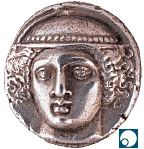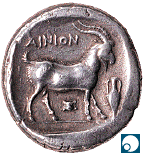



In a coin, especially an ancient coin, form follows function; its function
as legal currency controls many elements of both its production and its
design. To produce a coin a legitimate authority stamps a disk or lump of
metal of a certain purity and weight on one or, more usually, both sides
with designs ("types") and sometimes inscriptions ("legends").
The types and legends identify the authority and certify that the piece
of metal is legal currency, at least within the area governed by that authority.
The requirements then to produce a coin are: an authority to issue and guarantee
the coin's worth as money, possession of the bullion or metal from which
the coin will be made, the ability to refine the metal to the desired purity
or fineness, and the tools and techniques to fabricate the coin from the
metal. Almost all early coins were struck by hand, and the striking process
changed little from the beginning of coinage until the sixteenth century,
when coins began to be machine-milled. Striking coins by hand involved three
stages: making a blank (or "flan"), the plain lump or disk of
metal which when impressed with the types becomes the coin; making the dies,
the stamps used to transfer the types onto the flan; and striking the coin.
THE ISSUING AUTHORITY (Continues...)



The coin depicted above is No. 27
in the catalogue, tetradrachm of Ainos, c. 380 B.C. Obverse: Facing head
of Hermes.
All contents copyright (c) 1996.
Lawrence University
All rights reserved.